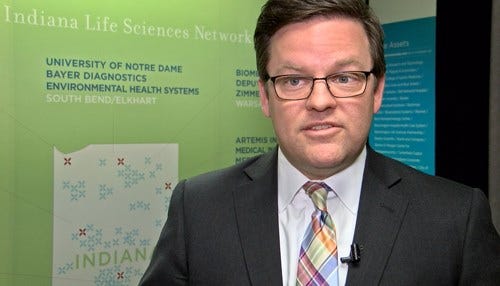Banner Year For Life Sciences VC
 Brian Stemme is project director at BioCrossroads.
Brian Stemme is project director at BioCrossroads.
Subscriber Benefit
As a subscriber you can listen to articles at work, in the car, or while you work out. Subscribe NowBioCrossroads, the state’s life sciences initiative, says Hoosier businesses in the sector received a record infusion from venture capital investors last year. The $107 million, Project Director Brian Stemme says, surpassed expectations and represents an $18 million increase from 2016. Indianapolis-based startup On Target Laboratories led the way with a $40 million investment from JJDC Inc., the venture capital unit of Johnson & Johnson (NYSE: JNJ).
In an interview with Inside INdiana Business Reporter Kylie Veleta in our most recent edition of Life Sciences INdiana, Stemme said Indiana compares well with its peers, but still lags nationally. "The road for life sciences companies to commercialize their products is long, risky and capital intensive. Each company will require novel science, strong leadership and tens or hundreds of millions in funding from investors – before a product is even launched. But with recent successes such as Assembly Biosciences, Orthopediatrics and Marcadia Biotech, Indiana has proven that it can attract venture capital and reward investors."
The total VC raised in Indiana from 1993 to 2002 was $80 million. In 2016, 2015 and 2014, the figures reached $89 million, $49 million and $105 million, respectively. In 2017, VC rounds ranged from $2 million to the aforementioned $40 million.
Stemme says there are challenges ahead for Indiana companies in the future. "Obviously, we want to have the investors here, when possible, but in many cases, because these dollar amounts are so large, they’re going to have to access investors in other regions," he said. "The way the business model works, if you’re going to raise $50 million, typically, that’s not going to be just from one investor in Indianapolis or Indiana, it’s got to be a series of investors in that syndicate and most likely in life sciences, there’s going to be somebody involved in another region."
Stemme says life sciences VC funding in Indiana is strong compared to similar states.
Stemme says local VC is a priority, but startups will often need to find money outside of Indiana.
